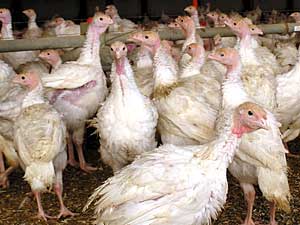|
Audio
Photos
More from MPR
Resources
|
St. Paul, Minn. — Minnesota has been planning for an outbreak of bird flu since 1999. State officials are modifying those plans now because of a highly aggressive form of avian flu circulating among domestic and wild birds in Asia. It has now spread to Eastern Europe.
Scientists worry the virus may mutate and learn how to spread from person to person, creating a pandemic. State epidemiologist Harry Hull says he can't estimate when -- or even if -- the flu will arrive in Minnesota.
"When is that going to happen? I can't tell you. Will it be this year? Well maybe, but it might be next year, maybe four or five years into the future, or it may never happen," Hull says.
Still, Hull and other state officials are planning for a number of scenarios in which an aggressive form of avian flu enters Minnesota.
There are three most likely scenarios. In the first scenario, wild birds would bring the virus to Minnesota and pass it along to other birds. If that happens, the state would quarantine bird populations here and kill infected birds. They'd step up surveillance of birds.
The second scenario envisions a few humans would get the virus, but it would be a type that's hard to transmit. If that happens, health officials would isolate those people and give them anti-viral medications. Health workers would also locate and notify everyone the patients had been in contact within the 72 hours before they got sick.
|
This is one of the moments that as a nation, as a state, as
communities we're going to have to be on our 'A' game.
- Gov. Tim Pawlenty
|
The last scenario is the most dramatic. In that case, avian flu would be highly contagious and there would be widespread cases.
In that case, the state would shut down public places, particularly schools, and consider closing certain workplaces. The state would start mass vaccinations as the drugs are available.
President Bush announced the government would stockpile enough vaccines for 25 percent of the U.S. population, primarily first responders and health care workers.
Gov. Pawlenty says the state will likely be eligible to get some of those vaccines, as well as antiviral drugs. But Minnesota needs to plan on stockpiling its own.
"We will take every available step to gain access to as many and as much antivirals and vaccines that are in the marketplace," says Pawlenty.
Pawlenty says he doesn't know how much the preparations for a flu pandemic will cost. President Bush has asked Congress to pump $7.1 billion into vaccines research, increased surveillance and stockpiling of medicines. It's not clear yet how much of that money would go to states.
Minnesota's Department of Homeland Security and Public Safety will oversee pandemic flu planning.
Right now, the agency is focused on getting the word out. Pawlenty says one challenge will be communicating with immigrant communities.
"We are affirmatively reaching out to Minnesota state councils in terms of our minority communities, immigrant community, ESL community, to make sure they have this information in a language they understand, and in a culturally appropriate way," says Pawlenty.
Pawlenty says the government needs to walk a fine line between informing people of the threat and alarming them. He and other leaders went out of their way to note that chicken is safe to eat, an important nod given Minnesota's $1.5 billion poultry industry.
Pawlenty admits all of this preparation may seem like overkill. But he says avian flu is not something to take chances with.
"As a nation, as a state, as a nation, as communities, we're going to have to be on our 'A' game," Pawlenty says. "We know not just from Katrina, but from natural disasters in Minnesota and elsewehere, is that it's better to be overprepared than not prepared."
So far, avian influenza has killed 62 people in Asia and infected more than 100 since 2003.






